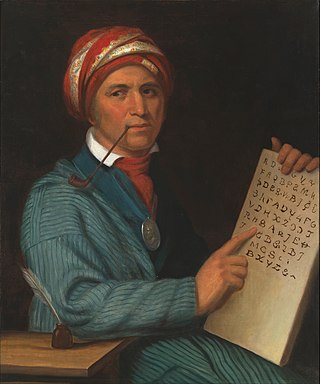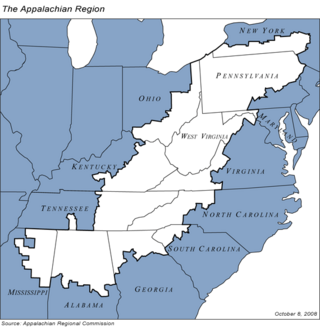
The Cherokee people are one of the Indigenous peoples of the Southeastern Woodlands of the United States. Prior to the 18th century, they were concentrated in their homelands, in towns along river valleys of what is now southwestern North Carolina, southeastern Tennessee, southwestern Virginia, edges of western South Carolina, northern Georgia and northeastern Alabama consisting of around 40,000 square miles.

Cherokee spiritual beliefs are held in common among the Cherokee people – Native American peoples who are Indigenous to the Southeastern Woodlands, and today live primarily in communities in North Carolina, and Oklahoma. Some of the beliefs, and the stories and songs in which they have been preserved, exist in slightly different forms in the different communities in which they have been preserved. But for the most part, they still form a unified system of theology.
SELU or selu may refer to:

Appalachia is a geographic region located in the central and southern sections of the Appalachian Mountains of the eastern United States. Its boundaries stretch from the western Catskill Mountains of New York into Pennsylvania, continuing on through the Blue Ridge Mountains and Great Smoky Mountains into northern Georgia, Alabama, and Mississippi, with West Virginia being the only state in which the entire state is within the boundaries of Appalachia. In 2021, the region was home to an estimated 26.3 million people, of whom roughly 80% were white.

Clingmans Dome is a mountain in the Great Smoky Mountains of Tennessee and North Carolina in the Southeastern United States. Its name in Cherokee is Kuwahi or Kuwohi, meaning "mulberry place."

Amicalola Falls State Park & Lodge is an 829-acre (3.35 km2) Georgia state park located between Ellijay and Dahlonega in Dawsonville, Georgia. The park's name is derived from a Cherokee language word meaning "tumbling waters". The park is home to Amicalola Falls, a 729-foot (222 m) waterfall that is the highest in Georgia. However, an analysis conducted by the World Waterfall Data base suggests that the main part of the falls is 429 ft (131 m) in height, followed by a prolonged gently sloping run in which the flow drops another 279 ft (85 m). It is considered to be one of the Seven Natural Wonders of Georgia. An 8-mile (13 km) trail that winds past Amicalola Falls and leads to Springer Mountain, famous as the southern terminus of the Appalachian Trail, begins in the park. Amicalola Falls State Park also offers many hiking trails, a guest lodge, restaurant, cabins, a shelter for long-distance Appalachian Trail hikers, a campground, and access to the eco-friendly Len Foote Hike Inn.
Marilou Awiakta is an American writer known for her poetry and essays about her experiences growing up in Oak Ridge, Tennessee.

Paula Gunn Allen was an American poet, literary critic, activist, professor, and novelist. Of mixed-race European-American, Arab-American, and Native American descent, she identified with her mother's people, the Laguna Pueblo. Gunn Allen wrote numerous essays, stories and poetry with Native American and feminist themes, and two biographies of Native American women. She edited four collections of Native American traditional stories and contemporary writing.

Kituwa or giduhwa (Cherokee:ᎩᏚᏩ) is a Woodland period Native American settlement near the upper Tuckasegee River, and is claimed by the Cherokee people as their original town. An earthwork platform mound, built about 1000 CE, marks a ceremonial site here. The historic Cherokee built a townhouse on top that was used for their communal gatherings and decisionmaking; they replaced it repeatedly over decades. They identify Kituwa as one of the "seven mother towns" in their traditional homeland of the American Southeast. This site is in modern Swain County, North Carolina, in the Great Smoky Mountains.
Debora Hammond is an American historian of science, former Provost and Professor Emerita of Interdisciplinary Studies of the Hutchins School of Liberal Studies at the Sonoma State University. She is known as author of the 2003 book The Science of Synthesis: Exploring the Social Implications of General Systems Theory, and as 2005–06 President of International Society for the Systems Sciences.

The Oconaluftee is the valley of the Oconaluftee River in the Great Smoky Mountains of North Carolina. Formerly the site of a Cherokee village and an Appalachian community, the valley is now North Carolina's main entrance to Great Smoky Mountains National Park.
Kay WalkingStick is a Native American landscape artist and a member of the Cherokee Nation. Her later landscape paintings, executed in oil paint on wood panels often include patterns based on Southwest American Indian rugs, pottery, and other artworks.

Chilhowee was a prehistoric and historic Native American site in present-day Blount and Monroe counties in Tennessee, in what were the Southeastern Woodlands. Although now submerged by the Chilhowee Lake impoundment of the Little Tennessee River, the Chilhowee site was home to a substantial 18th-century Overhill Cherokee town. It may have been the site of the older Creek village "Chalahume" visited by Spanish explorer Juan Pardo in 1567. The Cherokee later pushed the Muscogee Creek out of this area.

Pushing the Bear is a historical novel by Diane Glancy which explores the lives of the Cherokee in 1838/39 during their forced removal from their land along the Trail of Tears in the United States. The book was published in 1996 by Harcourt.
Byron Herbert Reece was an American poet and novelist. During his life, he published four volumes of poetry and two volumes of fiction.

Robert Sullivan is a Māori poet, academic and editor. His published poetry collections include Jazz Waiata (1990), Star Waka (1999) and Shout Ha! to the Sky (2010). His books are postmodern, explore social and racial issues, and explore aspects of Māori culture and history.
The Four Mothers Society or Four Mothers Nation is a religious, political, and traditionalist organization of Muscogee Creek, Cherokee, Choctaw and Chickasaw people, as well as the Natchez people enrolled in these tribes, in Oklahoma. It was formed in the 1890s as an opposition movement to the allotment policies of the Dawes Commission and various US Congressional acts of the period. The society is religious in nature. It opposed allotment because dividing tribal communal lands attacked the basis of their culture. In addition, some communal lands would be declared surplus and likely sold to non-Natives, causing the loss of their lands.
The moon-eyed people are a legendary group of short, bearded white-skinned people who are said to have lived in Appalachia until the Cherokee expelled them. Stories about them, attributed to Cherokee tradition, are mentioned by early European settlers in America. In a 1797 book, Benjamin Smith Barton explains they are called "moon-eyed" because they saw poorly during the day. Some stories claim they created the area's pre-Columbian ruins, and they disappeared from the area. Barton cited as his source a conversation with Colonel Leonard Marbury, an early settler of Georgia. Marbury, a Revolutionary War officer and a Congressman in the Second Provincial Congress of Georgia (1775), acted as intermediary between Native American Indians in the state of Georgia and the United States government.

Kim Shuck is a Cherokee Nation poet, author, weaver, and bead work artist who draws from Southeastern Native American culture and tradition as well as contemporary urban Indian life. She was born in San Francisco, California and belongs to the northern California Cherokee diaspora. She is an enrolled citizen of the Cherokee Nation of Oklahoma and also has Sac and Fox and Polish ancestry. She earned a B.A. in art (1994), and M.F.A. in Textiles (1998) from San Francisco State University. Her basket weaving work is influenced by her grandmother Etta Mae Rowe and the long history of California Native American basket making.

Appalachian folk art is a regional form of folk art based in the Appalachian region in the United States. In an article about the contemporary form of this art, Chuck Rosenak stated, "the definition of folk art is obscure". Folk art is a way to convey the feelings and mannerisms of cultures through handmade visual art and communicates a message to the observer. Though folk art itself was brought to the Americas by Europeans, it has adapted to each region and has cultivated traditions in each region.













